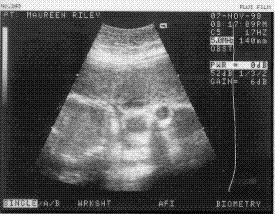|
We had a better day today after the scare of last
night. Nancy and Aivars visited in the morning and Ruth and Don visited
in the afternoon.
I was there in the morning by 8am for the ultrasound by Dr. Seaward.
By the end of the ultasound he was feeling more optimistic. He saw more
fluid around Baby "A" that he had detected the night before, and there
were good breathing motions. (Breathing motions are a sign of a well developed
baby. There is no transfer of oxygen occuring, but the baby is going through
the motions of breathing, with the diaphragm expanding and compressing
the lungs)
Both Baby "A" and Baby "B" are making theses motions as well as
other movements.
Maureen had a second ultrasound at 7:15pm tonight, and Baby "A" is
doing well. On the other hand, Baby "B" is starting to deteriotate. Last
Tuesday the blood flow in the cord started to show reversal. That situation
continues to occur and on top of that, the rate of heartbeat is decreasing.
Both babies were showing heartbeats in the range of 135 - 165, but now
"B"'s heart rate is in the 120-135 range.

(above is an image of Baby "A" taken today,
lying sideways,head on the right and body on the left,
with its mouth wide open, and its right eye visible)
It is looking like Baby "B"may not make it through the weekend.
The Placentas are separate so any problems with "B" should not affect
"A".
We are hoping and praying for the best, but "B" is small, and not
much amniotic fluid has been seen around it for a long time so it appears
to be fighting a losing battle. He/She has tried very hard, and it is a
miracle that it has lasted this long. Though sad, it is still comforting
to see and hear the heart of "B". We just hope that it does not suffer,
and that it wil go peacefully.
Maureen is due to be scanned again in the morning by Dr. Kingdom
(the placenta doctor) and we'll see what the situation is then. Both babies
are being scanned and followed during the ultrasound exams, but most attention
is being focused on how well Baby "A" is doing, and any problems with "A"
will force an intervention on its behalf.
I have done some research on the internet and here are some of the
things I have read (of course all information has to be researched to verify
its validity, but much of this corresponds with what we have been told
):
Low birth weight: Infants who weigh less than
5.5 pounds (2,500 grams) at birth are considered low birthweight and are
40 times more likely to die during the first month of life than normal
birthweight infants. They are also three times more likely to experience
serious health and developmental problems throughout their childhood.
- remember that our babies are 780 grams and
370 grams!
Preterm baby (preemie): Preterm birth is defined as birth
before the 37th week of gestation, calculated from the first day of the
woman's last normal menstrual period. A baby is considered full term if
born within 2 weeks of the "due date", (40 weeks after the last period).
The smallest preterm babies (weighing below 1500 grams) are two hundred
times more likely to die in the first year of life than babies born weighing
greater than 2500 grams. Even if they survive, these very small infants
are at 10 times greater risk of long term problems such as vision and hearing
complications, chronic lung disease, cerebral palsy, and other neurological
disorders.
- Maureen is currently only at 27 weeks +
2 days. The doctors are hoping she will make it to 28 weeks, but they keep
saying that every day is important. See the statistics below.
Premature baby survivability: Many
factors determine an individual baby's chances of survival.
The most important of these are:
-
The baby's gestational age (number of completed
weeks of pregnancy) at the time of birth
-
The baby's weight
-
The presence or absence of breathing problems
-
The presence or absence of congenital abnormalities
or malformations
-
The presence or absence of other severe diseases,
especially infection
In the smallest infants, gestational age is
usually most important because it determines if the infant's organs, particularly
the lungs, have developed enough to allow the baby to live within the limits
of our current technology. Your baby's doctor will be able to give you
the best estimate of your infant's chances since he/she can take into consideration
many of the above factors. But, no estimate is perfect. Some babies suddenly
get sick and die unexpectedly; others defy all odds. General estimates
of survival for live born infants who receive neonatal intensive care in
the USA in the 1990's are:
COMPLETED WEEKS
OF GESTATION AT BIRTH
(using last menstrual period)
|
SURVIVAL RATE
|
| 21 weeks and less |
0%
|
| 22 weeks |
0-10%*
|
| 23 weeks |
10-35%
|
| 24 weeks |
40-70%
|
| 25 weeks |
50-80%
|
| 26 weeks |
80-90%
|
| 27 weeks |
>90%
|
| 30 weeks |
>95%
|
| 34 weeks |
>98%
|
* Most babies at 22 weeks are not recuscitated
because survival without major disability is so rare.
A baby's chances for survival increases
3-4% per day between 23 and 24 weeks of gestation and about 2-3% per day
between 24 and 26 weeks of gestation. After
26 weeks the rate of survival increases at a much slower rate because survival
is high already.
-So, every day now counts!
And here is a link with interesting information:
Equipment
in a Neonatal Intensive care Unit
|
 |
